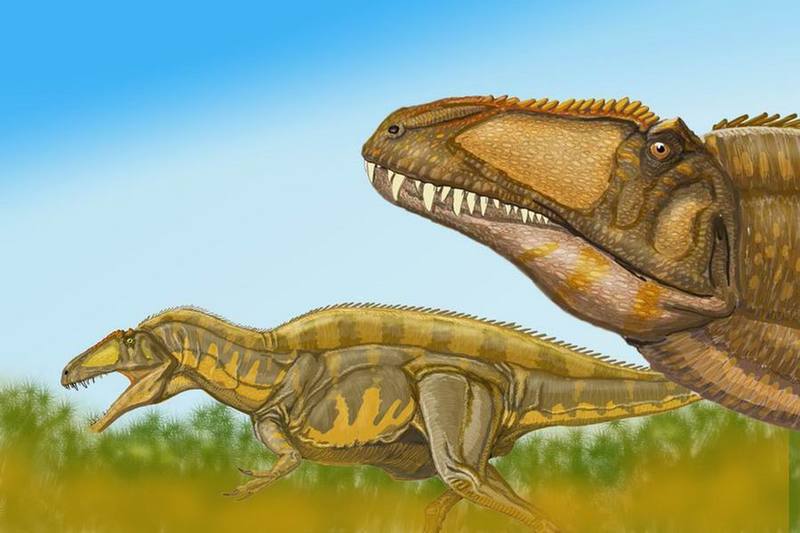Acrocanthosaurus
From Wikipedia, the free encyclopedia
[Photo] Acrocanthosaurus atokensis. From: http://en.wikipedia.org/wiki/Image:2Acrocant.jpg
Acrocanthosaurus (IPA: /æk??????kænθ????s??????s/) is a genus of carnosaurian theropod dinosaur from the mid-Cretaceous Period of what is now North America. It was one of the largest bipedal carnivorous dinosaurs, with one mounted specimen reaching a length of 11.5 meters (38.3 feet) and an estimated weight of 4.16 metric tonnes (4.6 tons). Many of its vertebrae had high neural spines.
General information
Acrocanthosaurus is named for its tall neural spines (projections of the vertebrae), from the Greek ακρα/akra meaning "high", ακανθα/akantha meaning "thorn" or 'spine' and σαυρο??/sauros meaning "lizard". There is one named species (A. atokensis), which is named after Atoka County in Oklahoma, where the original specimens were found. It was named in 1950 by American paleontologists J. Willis Stovall and Wann Langston, Jr..
The holotype and paratype, described at the same time in 1950, consist of two partial skeletons and a bit of skull material from the Antlers Formation in the U.S. state of Oklahoma. Two more complete skeletons have recently been described. The first is a skeleton about 70% complete, including some of the skull, recovered from the Twin Mountain Formation of Texas and currently part of the Fort Worth Museum of Science and History collection (Harris, 1998). An even more complete skeleton (nicknamed "Fran") was recovered from the Antlers and is now housed at the North Carolina Museum of Natural Sciences. This specimen includes the only known complete skull (Currie & Carpenter, 2000). Many other fragments and individual bones have been found all over north Texas, Oklahoma, and possibly Arizona. The Antlers Formation is composed of sediment from the Aptian through Albian stages of the Cretaceous Period, while the Twin Mountain is restricted to the Aptian. Therefore, Acrocanthosaurus lived between 125 and 100 million years ago. Other dinosaurs from this time and place include Pleurocoelus, Deinonychus, Sauroposeidon, and Tenontosaurus.
Another species from England was at one point named Acrocanthosaurus altispinax, but has since been removed to its own genus, Becklespinax.
Modern phylogenetic analyses put Acrocanthosaurus inside the group Allosauroidea, but there is some dispute over the exact position of Acrocanthosaurus within that group. It was originally placed in Allosauridae with Allosaurus, an arrangement also supported by some later studies (Stovall & Langston, 1950; Currie & Carpenter, 2000; Coria & Currie, 2002, 2006; Novas et al., 2005). Many other scientists put it in Carcharodontosauridae with Carcharodontosaurus and Giganotosaurus (Sereno et al., 1996; Harris, 1998; Naish et al., 2001; Holtz et al., 2004; Franzosa & Rowe, 2005).
Dorsal spines
The most notable feature of Acrocanthosaurus are the tall neural spines, located on the back, hips and upper tail, which can be more than 2.5 times the height of the vertebrae from which they extend. Other dinosaurs also had high spines on the back, sometimes much higher than Acrocanthosaurus. For instance, the African Spinosaurus had spines nearly 2 meters tall, which is about 15 times taller than the central (bodies) of the vertebrae to which they are attached. The spines may have been covered in muscle or fat like those of a modern bison, forming a tall, thick ridge down its back.
The function of the spines remains unknown, although they may have been involved in communication, fat storage, or temperature control.
Possible footprints
The famous Glen Rose trackway site in Dinosaur Valley State Park of north Texas contains many footprints, including three-toed theropod prints that some paleontologists have associated with Acrocanthosaurus. It is impossible to say what animal made the prints, since no fossil bones were discovered there. However, the footprints are of an appropriate size, and the Glen Rose Formation is near the Antlers and Twin Mountain Formations, and roughly the same age, so it is quite possible that the footprints do indeed belong to Acrocanthosaurus.
The theropod footprints belong to several individuals moving in the same direction as several individual sauropod dinosaurs. The theropod prints are sometimes found on top of the sauropod footprints, indicating that they were formed later. This has been put forth as evidence that a small pack of Acrocanthosaurus was stalking a herd of sauropods.
While interesting and plausible, this hypothesis is difficult to prove and other explanations exist. For example, several solitary theropods may have moved through in the same direction at different times after the sauropods had passed, creating the appearance of a pack stalking its prey. The same can be said for the purported "herd" of sauropods, who also may or may not have been moving as a group.
Brain structure
In 2005, scientists Jonathan Franzosa and Timothy Rowe digitally reconstructed an endocast (replica) of the brain and cranial nerves of Acrocanthosaurus using computed tomography (CT) scanning technology to analyze the spaces within the holotype braincase. This allowed them to make several observations:
The olfactory bulbs were large and bulbous, indicating a good sense of smell.
- Reconstructing the semicircular canals of the ear, which control balance, shows that the head was held at a 25-degree angle below horizontal. This was determined by orienting the endocast so that the horizontal semicircular canal was level with a transverse plane, as it would have been in life.
- The shape of the brain is slightly sigmoidal (S-shaped), without much expansion of the cerebral hemispheres, more like a crocodile than a bird.
- The brain looks more like Carcharodontosaurus and Giganotosaurus than either Allosaurus or Sinraptor, providing support for the hypothesis that Acrocanthosaurus was a carcharodontosaurid.
Digital endocasts have also been created for several other large theropods: Tyrannosaurus, Ceratosaurus, Allosaurus, and Carcharodontosaurus.
http://en.wikipedia.org/wiki/Acrocanthosaurus
| The text in this page is based on the copyrighted Wikipedia article shown in above URL. It is used under the GNU Free Documentation License. You may redistribute it, verbatim or modified, providing that you comply with the terms of the GFDL. |
|

